Ever since Dr. Olga Colli’s Spanish classes in high school, when I first glimpsed Antoni Gaudí’s Basilica de la Sagrada Familia in the ALM textbook, I have longed to visit Barcelona and experience this remarkable church first-hand. Little did I dream that the same textbook had a similar impact on my husband, Michael, although we studied Spanish at different times and in different states. It wasn’t until we were planning our annual business trip to France, and decided to make a side-trip somewhere within a two-hour flight radius of Paris, that we hit on Barcelona.
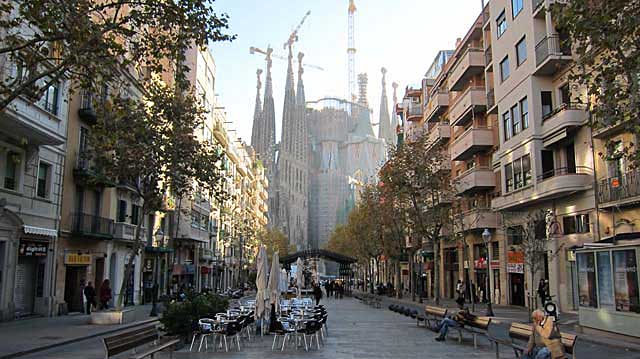
We discovered that the photo in our textbook had ignited a lifelong desire to visit the massive Modernismo church framed by tall, slim towers designed and built (or at least started) by this enigmatic Catalan architect and engineer. Surely, we presumed, five days would be sufficient to visit all of Gaudí’s magnificent buildings in the city he called home, while we enjoyed a host of regional tapas and wines. How wrong we were.
The morning following our arrival, we set off for the Basilica and opted not only for a ticket admitting us to the church but also one for the elevator ride to the top of the Passion Tower, close to 500 feet tall. Begun in 1872 when Gaudi was just 31 years old, the Basilica was his passion for the next 43 years. He lived and worked at the site while taking on a host of other commissions in the city and the region. Still unfinished when he was killed by a streetcar in 1926, construction stalled for almost three decades, taken up again in 1954, but still not complete as evidenced by the presence of numerous tower cranes.
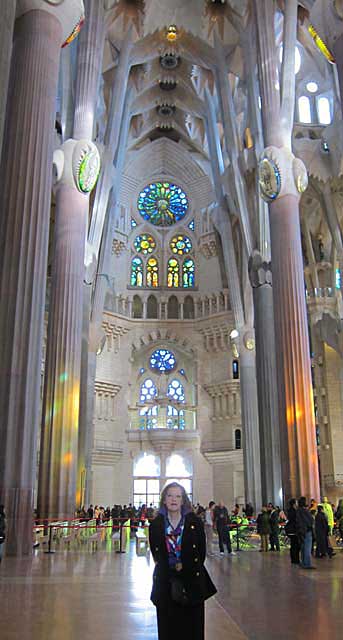
Taking inspiration from shapes Gaudí observed in nature, the nave is breathtaking in its height of some 245 feet, framed by pillars that branch upward like tree trunks and are crowned by semicircular shapes with zigzag edges resembling giant leaves. Despite the massive elements supporting this tallest of churches, sunlight filtered through enormous skylights in the ceiling and massive windows in the walls imparted lightness and a mystical intensity as we wandered the knave and apse.
The ride to the top of the Passion Tower in the tiny elevator, admitting only four people plus the operator, is not for the claustrophobe. Thankfully, Michael resisted the urge to ask how often it got stuck until after we had spent a tortuous five minutes on the tower’s vertigo-inducing sky-high walkway and descended safely to earth. “About twice a month” was the operator’s response, “but no one has ever been hurt.” “Just scared to death!” we muttered as we returned to the nave and gave thanks for surviving the journey.
Our intention had been to visit all of the Gaudí buildings within the city’s limits but we fell hopelessly short of our goal. There was just too much to explore and admire in the first few we encountered, as we expended precious time on scholarly exhibits and fascinating interactive displays about Gaudí’s designs and construction techniques. Our pace slowed to a crawl. Even the gift shops were marvels, chock-full of scholarly information about Gaudí and the Modernismo movement in Catalonia in addition to coffee mugs and t-shirts emblazoned with iconic Gaudí chimneys.
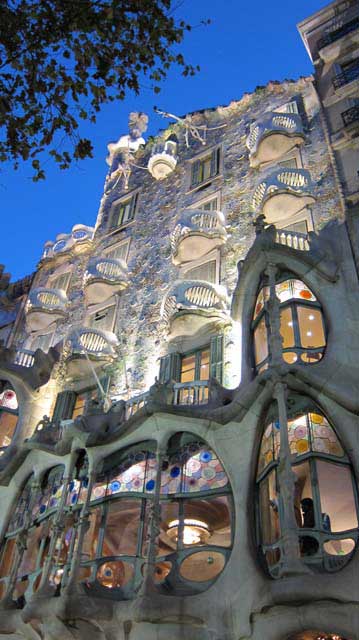
We loved that residential commissions such as La Pedrera apartment building (also known as the Milà), the Casa Battló and the Palau Güell encouraged poking around from basement to roof and examining countless decorative details such as door knobs, window frames, and lighting fixtures, as well as pieces of furniture that Gaudí had designed along with the buildings housing them. How could one man have had the imagination and the engineering ability to create all these things in just one lifetime?
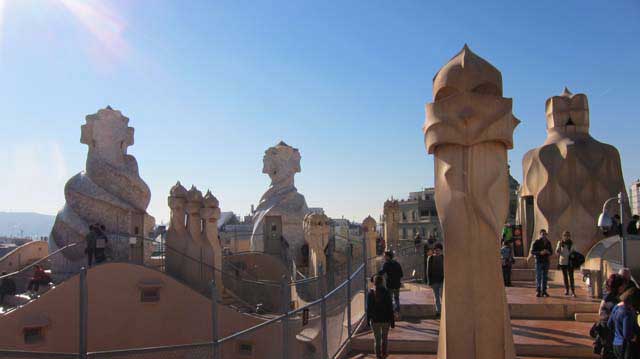
What intrigued us especially were the eclectic designs of the chimneys atop these buildings. More than just tubes through which smoke escapes, these are artistic triumphs in their own right. Some resembled clusters of medieval helmeted soldiers, others fir trees, and still others papier-mâché clown hats. All command attention and dazzle visitors with their colorful, almost whimsical designs, on rooftops whose undulating surface makes clambering about challenging.
In between visits to Gaudí’s masterpieces, we found time for tapas and regional wines at eateries around the city. We grew to adore the variety and creativity of tapas on a visit to Madrid some years back, so the chance to experience the Catalan take on these small, satisfying dishes proved irresistible. As a coastal city, Barcelona offered a wealth of seafood-themed tapas including what turned out to be our favorite — octopus prepared in numerous ways.
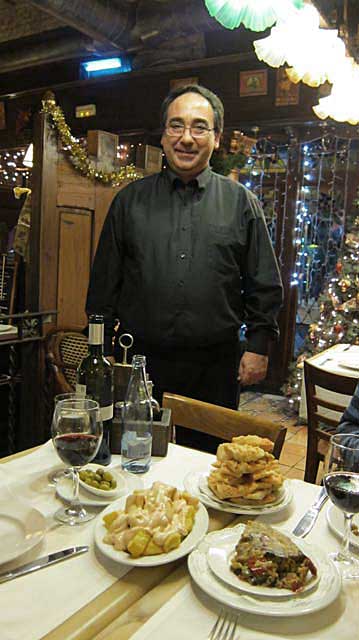
The most memorable selection of tapas was at El Puchero de Baralantra, a tiny establishment catty-corner from our hotel and, thankfully, open on a Sunday evening when we wanted to celebrate Michael’s birthday with our friend from France, Pierre, who was working in Barcelona. Guided by our knowledgeable and charismatic waiter, José, our favorite offering turned out to be tacos de filete de ternera al Roquefort — succulent strips of roasted veal in a creamy sauce of Roquefort cheese. Less rich but equally memorable were the pimientos al padrón — sweet green peppers the size of jalapeños but without the heat, roasted to perfection and sprinkled with sea salt. We were unable to resist a staple of tapas cuisine that found its pinnacle at El Puchero — patatas bravas — little discs of potatoes fried to perfection and smothered in aioli. To accompany these and other dishes we enjoyed a local red wine, a blend of cabernet sauvignon and tempranillo from the Raimat winery in the Costers del Segre region of Catalonia.
We found Barcelona a richly cosmopolitan place with the perfect wintertime climate, sunny but not too cold. This city demands strolling, not just on the wide boulevards such as Las Ramblas, but the side streets and small parks as well. The only drawback is the scourge of petty thieves, characterized by the locals as gypsies, who prey on tourists using elaborate schemes and misdirection designed to separate us from purses, wallets, and jewelry. If only all that creativity had been invested in legitimate enterprise, the EU’s economic woes would vanish! Fortunately, we were provided with a one-page summary of chicaneries when we checked in at the Hotel Dante. The thug who surreptitiously threw a wad of goop on Michael’s jacket and then “volunteered” to wash it off was befuddled by our lack of valuables and eventually ambled off in search of more lucrative prey. Without the hotel’s warning and carefully securing our valuables, our entire trip might have gone up in smoke.
Restaurante El Puchero de Baralantra - Muntaner 103 (corner of Mallorca), 08036 Barcelona
Hotel Dante, Mallorca, 181, 08036 Barcelona
Next time, a visit to a best-kept secret with a resurgent wine industry.
The original version of this article appeared in the Spring, 2014 edition of the Quarterly Newsletter of the Wine Society of Texas, a non-profit organization dedicated to wine education and appreciation.